AIZEN Bulletin
2017/2018
The AIZEN is twenty-seven years old. As a sign of its renewal, a young, dynamic and talented new team will take over in September 2018, under the presidency of Juliana Starr. A member of the AIZEN for twenty years, Juliana co-organized and hosted the conference on Émile Zola and Naturalism at the University of New Orleans in 2014. Besides the fact that it was the first time an AIZEN conference was held in the American South, a highly symbolic location, as a French outpost during the birth of naturalism in Europe, this conference welcomed more than one hundred participants and was extremely successful thanks to Juliana Starr’s outstanding efforts and creativity. For this reason, she has been chosen unanimously and without hesitation as the new President of the AIZEN. She and her team will undertake the preparation of festivities to celebrate the thirtieth anniversary of this Association, henceforth well established and known throughout the world.


Congratulations, therefore, to Juliana and her new team: Carmen Mayer (University of Alabama), Vice-President; Ana Oancea (University of Delaware), Secretary; Hamp Overton (University of New Orleans), Treasurer; Jeremy Worth (University of Windsor), Communications Officer; Justine Huet (Mount Royal University), AIZEN Assistant. A warm thank you to Robert Singer, for having served as Vice-President of the AIZEN for twenty-five years. Professor Singer will now enjoy a well-deserved change of pace, during his retirement. A huge thank you to Carolyn Snipes-Hoyt who, has served as Secretary-Treasurer of the AIZEN for twenty years. She has played a very important role in the AIZEN, since she has also been the Co-Editor of the AIZEN Bulletin and the Associate Editor of our Review Excavatio. As for Anna Gural-Migdal, she deserves hearty congratulations, for her status from now on as Professor Emerita, since her retirement, and Honorary President of the AIZEN. Her name and indefatigable efforts during the last twenty-five years are honoured by this Association which has flourished under her direction.

Juliana Starr, new President of the AIZEN
CONFERENCE REPORT
The most recent conference, which Anna Gural-Migdal co-organized with Sándor Kálai at the University of Debrecen, in Hungary, once again revealed the capacity of the AIZEN to establish productive relations on the four corners of the Earth, so that research on naturalism can move forward all over the world. Our Association’s eighteenth international conference, titled “Zola, Mirbeau and Naturalism,” took place from June 8-10, 2017. This conference had a part in the commemorative events for the Mirbeau Centenary, celebrating Zola’s important contemporary. The initiative for this celebration was encouraged by the Société Octave Mirbeau and its President, Pierre Michel, whom we would like to thank.
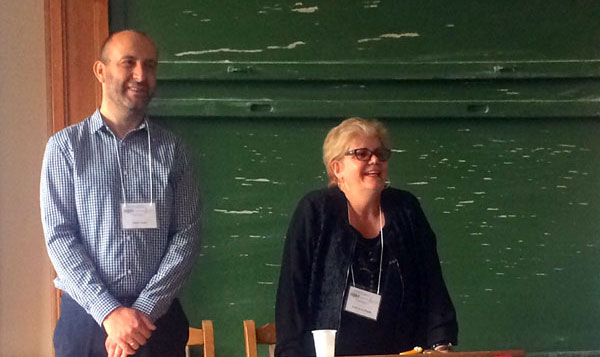
From left: Sándor Kálai and Anna Gural-Migdal
The conference had as its objective to underscore what brings Zola and Mirbeau together, or at least justifies a comparison, in order to inspire a renewed reflection on the Zolian heritage and on the conception of naturalism. Such goals echoed not only the intellectual project of our Association, but they also allowed us to present a very original commemorative event. Our collaboration with the University of Debrecen gave us, furthermore, the opportunity to organize a conference in Central Europe and to appreciate the scope of Zola’s and Mirbeau’s influence in this cosmopolitan cultural space, specifically through the diffusion and reception of their writings. Moreover, we made it our objective to highlight the influence of naturalism on Central European writers, such as those from Hungary, Poland, Austria or Slovakia, while at the same time respecting the specific regional and national characteristics of their works.
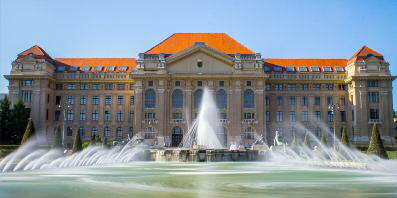
University of Debrecen
All during its 27 years of existence, the AIZEN has never ceased to emphasize a unique critical approach, pluri- and inter-disciplinary. Two fields of study have been privileged these last few years: on the one hand, a reflection on naturalism and neo-naturalism in North America, South America and in Europe; on the other hand, an exploration of the naturalist text in the areas of cinema and painting. Other than the fact that our conference in Debrecen remained within this continuity, priority was also accorded this time to the medias, since both Zola and Mirbeau not only had in common their defense of modern art in their articles, but also were very involved journalists in other ways as well, including during the Dreyfus Affair, a major media event of the late 19th Century.
.jpg)
Captain Alfred Dreyfus
We are proud to have collaborated with the Department of French Studies and the Department of Communication and Media Studies in a highly regarded and leading European University such as the University of Debrecen. On behalf of the Executive Committee of our Association, we would like to extend our thanks and deep appreciation to this institution for sponsoring and hosting the International AIZEN/University of Debrecen Conference. Our gratitude especially goes to Zoltán Szilvássy, Rector of the University of Debrecen, Bartha Elek, Vice Rector for Academic Affairs, and Klára Papp, Dean of the Faculty of Humanities. A hearty thank you to Péter Szirák, Professor and Chair of the Department of Communication and Media Studies. And a huge thank you to Anna Keszeg for all her work in the local preparation of the event. Finally, and foremost, Anna Gural-Migdal would like to convey her deep appreciation to Sándor Kálai, specialist in Zola, Mirbeau, popular literature and media culture. Thanks to his collaboration, the project was undertaken to hold this conference at the University of Debrecen. It has been a great pleasure to organize this event with him and we cannot begin to express our indebtedness to him for all his efforts to ensure its success.
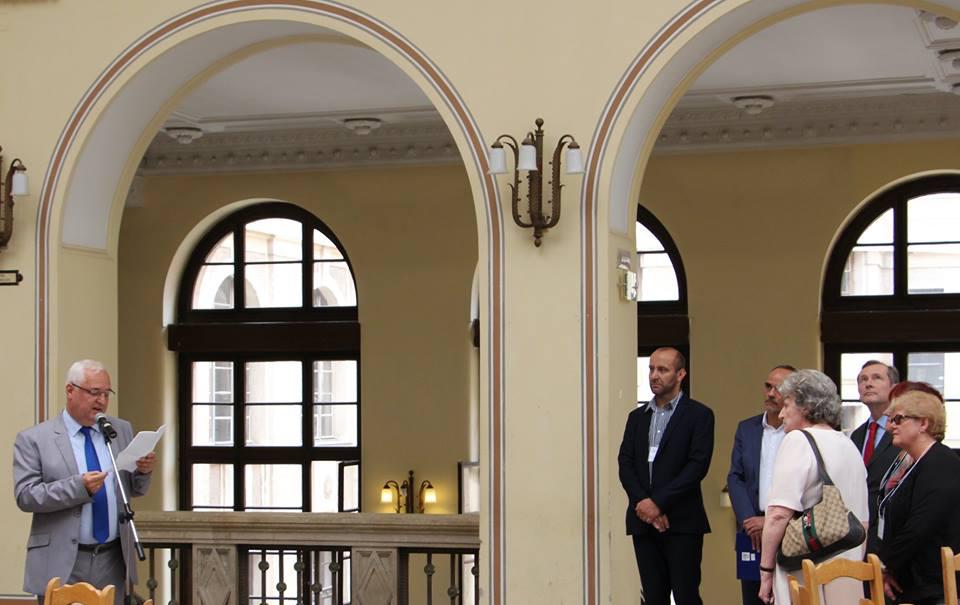
Bartha Elek, Vice Rector for Academic Affairs, University of Debrecen
The exceptional character of this conference was also a result of the presence of Dr. Brigitte Émile-Zola, great-granddaughter of the writer and member of the AIZEN since its foundation. We extend heartfelt thanks to Brigitte for her friendship and her unconditional support of the AIZEN. This was her first visit to Hungary and it was an honour to have her attend this conference. Dr. Émile-Zola trained and worked as a physician and has now devoted herself in her retirement to writing and circulating the archives from her personal collection, including letters Zola received from all over the world. We also had the pleasure to welcome three European invited speakers: Éléonore Reverzy, Professor of 19th-century French literature at the Université Sorbonne Nouvelle-Paris 3; Susan Harrow, Ashley Watkins Professor of French at the University of Bristol; and Miklós Konrád, researcher at the Institute of History at the Research Centre in Human Sciences of the Hungarian Academy of Sciences. Thank you to all three for their participation in this conference.
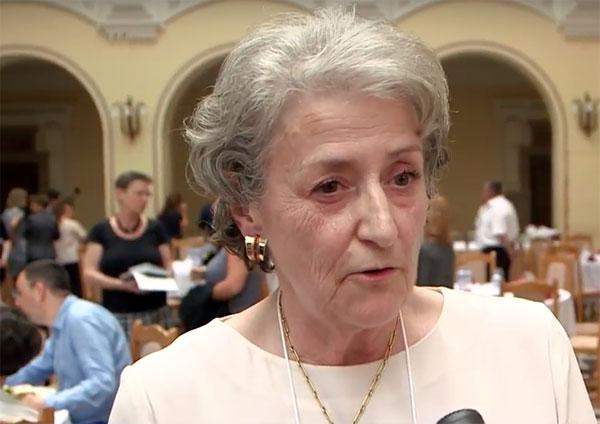
Brigitte Émile Zola giving an interview with the press
This symposium, through the richness of its content and its highly international dimension, honoured the University of Debrecen by bringing to its doors talented participants from three continents and seventeen countries: Belgium, Brazil, Canada, England, Finland, Germany, France, Japan, Hungary, Poland, Portugal, Romania, Russia, Slovakia, Switzerland, the United States, and West Bank. A big thank you, therefore, to all conference-goers for having, once again, responded with enthusiasm, coming from so far, and contributing to the excellent intellectual level of the offerings. Hats off to the delegation of professors and scholars from Brazil for their presentation of a very solid panel on the reception of Zola and naturalism in their country.

Delegation from Brazil. From left: Leonardo Pinto Mendes, Haroldo Ceravolo Sereza, Pedro Paulo Catharina and Orna Messer Levin

Audience
This important intellectual and commemorative event could not have taken place without the dignitaries from Hungary and France. We are therefore thrilled that the French Ambassador to Hungary, Éric Fournier, honoured us with his presence and that the conference was held under the patronage of the French Embassy in Budapest. We would also like to offer our thanks to Hervé Ferrage, Director of the Institut français de Budapest. The conference enjoyed the support of important organizations which helped us to recruit young researchers and rising talents, one of the AIZEN’s missions since its inception. Thanks to Alain Pagès, Director of the Centre Zola/ITEM in Paris and Jean-Sébastien Macke, Ingénieur d’études at ITEM and CNRS, for their generous assistance. We would also like to express our thanks to Chantal Morel, one of the founders of the Emile Zola Society London, for her fruitful collaboration with our Association.

Alain Pagès
The enormous amount of work that goes into the preparation of such a conference could never have been accomplished without the great job of the AIZEN team. Thank you to Carolyn Snipes-Hoyt, Secretary-Treasurer of the AIZEN and Associate Professor at Burman University, Canada, for her remarkable efforts that have contributed to the huge success of our Association. A big thank you to Justine Huet, Assistant to the AIZEN and Assistant Professor at Mount Royal University, Canada, for her dynamism and very efficient collaboration. Thank you also to Jeremy Worth, Associate Professor at the University of Windsor, Canada, for taking charge of AIZEN’s Facebook and Twitter Communication. We are delighted that all of them could join us in Debrecen!
Upon arrival at the University of Debrecen, participants were struck by the beauty of the surroundings and the campus. On the plaza in front of the Main Building, there are statues, a large pool, and fountains. The path leading from the Hotel Nagyerdö, where most of the participants stayed, to the University winds through a beautiful wooded area with ponds, ducks and lily pads, and goes by an outdoor restaurant where we could stop for a bite and relax.

A relaxing stop on the path from the hotel to the University of Debrecen
The university’s Main Building exudes old-world charm, both outside and in, and no wonder: the University of Debrecen has a long history, since it was founded during the Reformation, in 1538 as a Protestant Seminary, and is now part of the city’s historical patrimony. It became the University of Debrecen in 1912. In its beautiful library, Leonárd Petró, Lászlo Szabó and Eszter Tóth organized a special Book Exhibit on Naturalism and Naturalist Writers in Hungary. Visitors to the exhibit were welcomed as well by Krisztina Braun. We thank the Library staff for their interest in our symposium and their collaboration. It was impressive to see the rare translations of works by Zola and Mirbeau, as well as the critical works in Hungarian on naturalism and European naturalist writers.
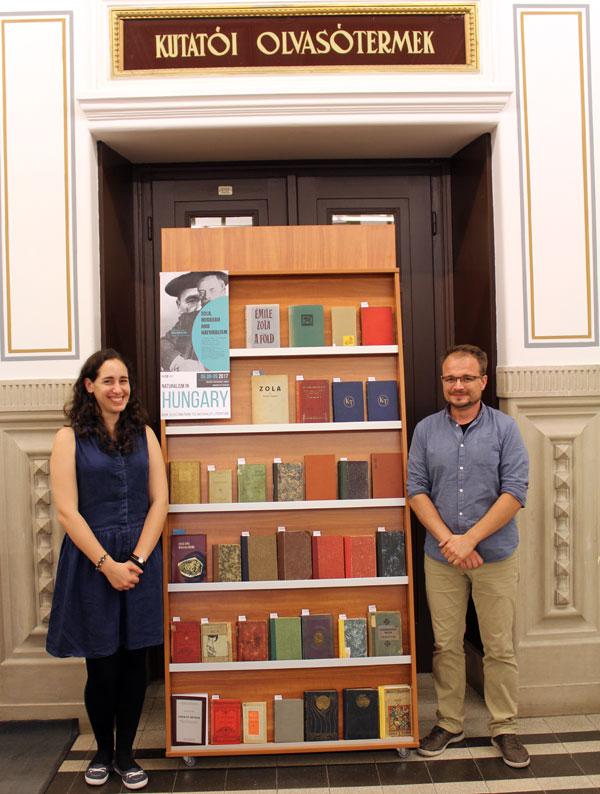
From left: Krisztina Braun and Leonárd Petró, librarians
On Thursday morning, after registration in the stately Entrance Hall of the lovely Main Building, on the 3rd floor, conference-goers were invited to listen to the Opening Speech by Anna Gural-Migdal and a special tribute to Octave Mirbeau by Sándor Kálai. Before the Reception and Lunch Buffet, offered by the University of Debrecen and the Mayor of Debrecen, two sessions, Naturalism and Naturalist Writers in Europe and Taking Sides on Issues: Zola and Mirbeau, opened the conference and articulated its main themes. The reception began with an elegant buffet, featuring local specialties, pastries, and champagne, which we enjoyed and then listened to the speeches of Éric Fournier, French Ambassador to Hungary, Bartha Elek, Vice Rector for Academic Affairs, and Hervé Ferrage, Director of the Institut français de Budapest.
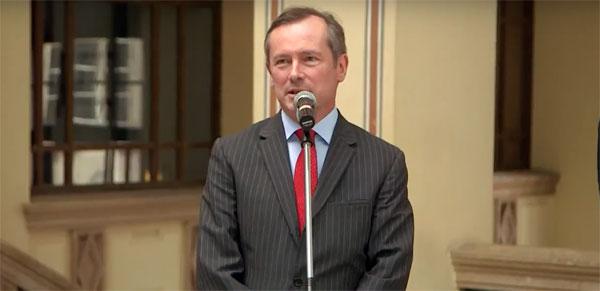
Éric Fournier, French Ambassador to Hungary
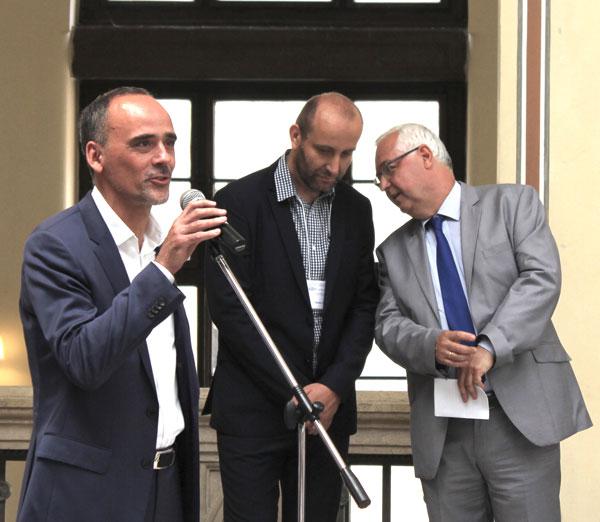
From left: Hervé Ferrage, Sándor Kalái and Bartha Elek
Journalists from the Hungarian press and television were present to cover the event, which aired on the local news. Conference-goers will be able to see themselves filmed for television at the following electronic address: https://www.youtube.com/watch?v=UTSmvBwdHSA. An audiovisual document prepared to promote our conference can also be found on YouTube at the following address: https://www.youtube.com/watch?v=hWqNq91q47g. Another audiovisual document presents interviews with Brigitte Émile-Zola, the French Ambassador, invited speakers and the conference organizers: https://www.youtube.com/watch?v=hUc0NfznrPQ. On this latter, one can catch a glimpse of the beautiful scenery around the campus in Debrecen. A dozen articles about the conference were published in Hungarian newspapers, and many of them are available on-line. This event was therefore also a huge success in terms of capturing media attention.

Filming for television.
In the early afternoon, conference-goers had the privilege of listening to the presentation by Éléonore Reverzy, the first Invited Guest: “Mirbeau romancier pédagogue.” Her paper proposed a transversal reading of Mirbeau’s novels, meant to draw attention to pedagogical figures and educational moments. It is known that Mirbeau condemned religious education partly because of his own experiences. The novels are populated with bad teachers or with women who play the role of educators, or make statements promulgating knowledge about the meaning of life. The strategies of “pedagogical fiction” serve not only to destabilize actual pedagogy; but also − through the repetition of tautological figures − they point to the elusive dimension of knowledge. The sessions which followed dealt with archives, that is, articles or letters published by Mirbeau and Zola’s chronicles. In the parallel session, a panel took place on the presence of Zola’s fictional works in Brazil, not only through the study of debates he raised on the difference between realism and naturalism, but also by examining the way the pornographic dimension of the Rougon-Macquart was received and the theatrical adaptations of Zola’s novels in that country. Finally, the day ended with a session devoted entirely to original contemporary interpretations of Zola’s novels, including one about Au Bonheur des Dames and two of its adaptations: Julien Divivier’s film (1930); and the television series The Paradise, aired by the BBC in 2012. A parallel session devoted entirely to the cinema prepared the audience for the Naturalist Film Festival which followed in the evening.
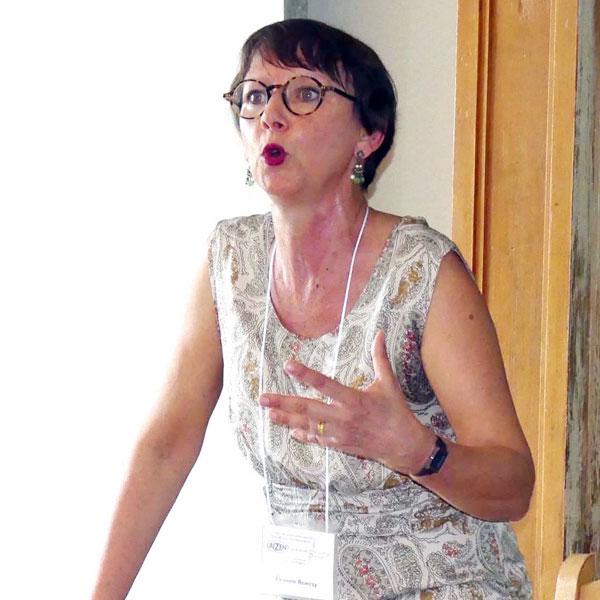
Éléonore Reverzy
On the program was the recent film Journal d’une femme de chambre (Benoît Jacquot, 2015, France and Belgium, 95 min., colour, in French with English subtitles), an adaptation of Octave Mirbeau’s novel (1900) of the same title with Léa Seydoux as Célestine, an ambitious young woman who works as a chambermaid for a wealthy couple in contemporary France. Jacquot’s adaptation differs from Luis Buñuel’s 1964 version in its respect for the original text, but also in its emphasis on crime, horror, and monstrosity. There was a showing as well of Halles (André Galitzine and Boris Kaufman, 1929, France, 22 min., black and white, silent), in which workers in the actual location in central Paris are unloading foodstuffs, with the market’s nightlife in full swing around them. Halles is much more than a reference to Zola’s novel Le Ventre de Paris and naturalism. This silent documentary promotes Dziga Vertov’s concept of kino-pravda (film truth), as it conveys the optimistic revolutionary spirit of Soviet cinema of the 1920s and a strong belief in the worker. The final film, Son of Saul (Lázló Nemes, 2015, Hungary, 107 min., in Hungarian with English subtitles) is set in Auschwitz during World War II, recording 36 hours in the life of Saul Ausländer (played by Géza Röhrig), a Hungarian member of the Sonderkommando. Nemes’s idea for the film took its inspirations from The Scrolls of Auschwitz, a collection of testimonials by Sonderkommando members. Son of Saul won the Grand Prix at the 2015 Cannes Film Festival and was voted Best Foreign Language Film at the 88th Academy Awards Ceremony.


The projection of these films attracted many, including Brigitte Émile-Zola, the French Ambassador and the Director of the Institut français de Budapest. A special thank you to Justine Huet, who took charge of the screening and led out in the presentation of the films, with Zsolt Györ. Thank you also to Elisabeth-Christine Muelsch for her introduction to the film Halles. This was a very eventful first day of the conference, ending at midnight.
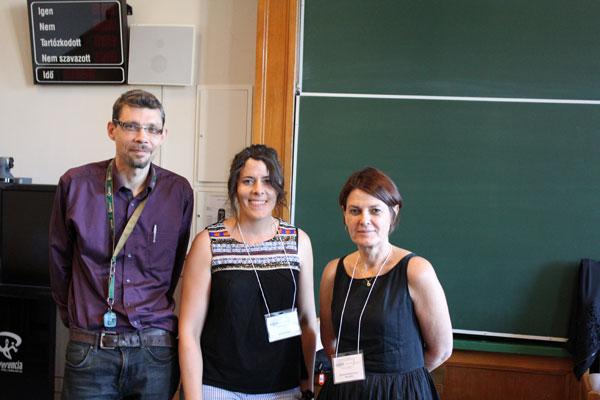
From left: Zsolt Győr, Justine Huet and Elisabeth-Christine Muelsch
The second day of the conference was as dense as the first. The morning began with two sessions on Zola and Mirbeau: one on the decadent motifs found in the novels of these authors; the other on their novelistic poetics. These sessions were followed by two others: the first dealt with the Dreyfus Affair, specifically the ways Zola and Mirbeau involved themselves in this judicial case, and the repercussions of the Affair were considered, as far afield as in Brazil; the second parallel session offered new perspectives on naturalism, its relationship to phenomenology and to horror in literature and film. After an excellent lunch buffet, conference-goers were invited to listen to our second Invited Guest Speaker, Susan Harrow, whose paper was titled “Seeing Solitude: Alone together in Zola’s Rougon-Macquart and Related Visual Culture,” in which she proposed a trans-historical and trans-cultural approach to solitude, with an examination of novels in the Rougon-Macquart cycle illustrating this theme with corresponding paintings from the period. She made the point that Zola’s works are often associated with social and community values, but that we nevertheless find a significant accent placed on solitude, viewed in an unusual way, as a desired withdrawal resulting in introspection. The following session dealt entirely with Mirbeau, touching on the question of trauma in naturalism through a consideration of motifs such as rape, hysteria and bloody suicide. The parallel session dealt with Zola’s and Mirbeau’s aesthetic, political and ethical fights in the context of the Dreyfus Affair.

Susan Harrow
The last two sessions were devoted to the relationship between journalism and the visual arts, in Zola and Mirbeau. The session titled Zola, Mirbeau and Contemporary Journalism focused on other aspects of journalism, including the satirical ways these authors were represented in the press, in an uneven manner. Zola appeared constantly ridiculed by caricaturists, while Mirbeau figured in drawings much less often and with more dignity than his contemporary. The history of the novel is inscribed in visual and media culture, as was shown in the session titled Zola, Mirbeau and the Arts. These writers had in common a journalistic conception of art criticism as putting forward a contentious point of view. Traces of their aesthetic convictions can be found in the artist novels they left as a legacy. In the same way, one can retrace the two authors’ notions about impressionism, to clarify the way this pictural movement influenced their novelistic practice.
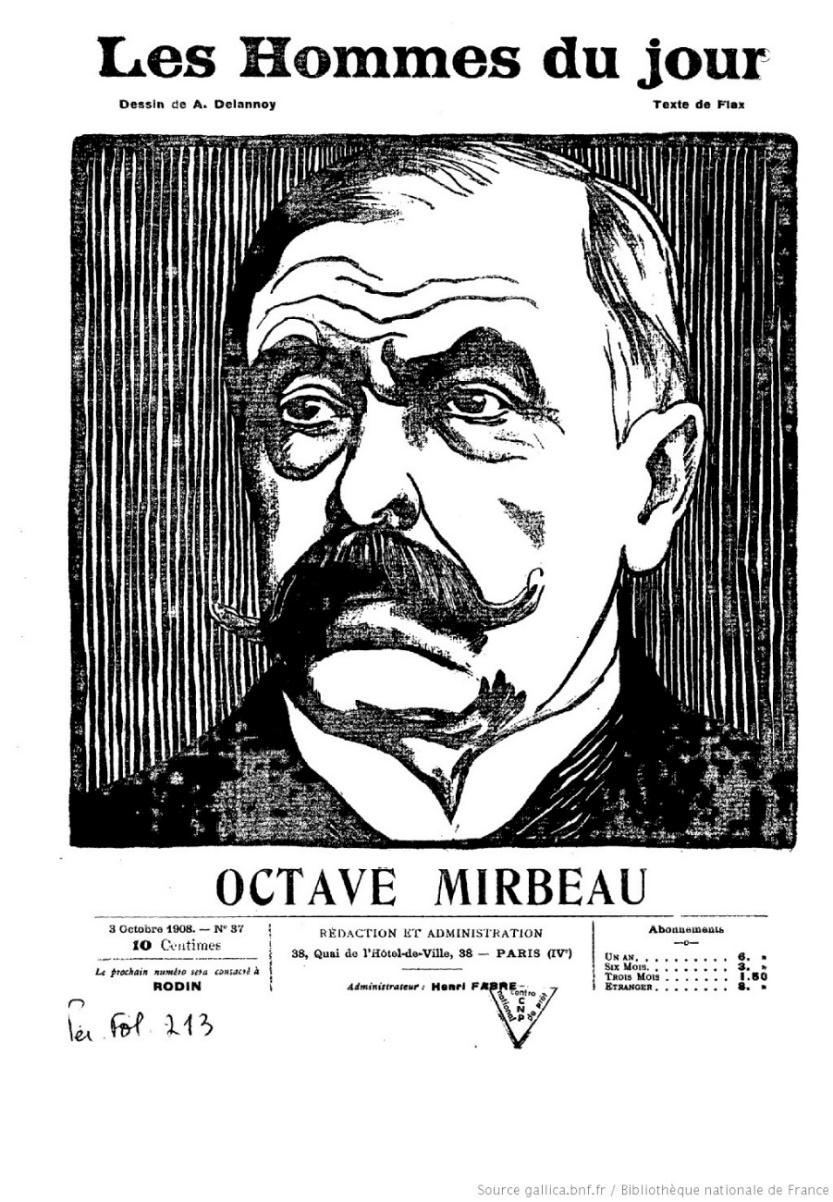
Drawing by A. Delannoy, “Octave Mirbeau,” Les Hommes du jour, 3 october 1908
At the end of this day, filled with excellent conference papers, as was the preceeding, we had the pleasure of making our way to the restaurant Flaska Vendéglő to take part in the traditional AIZEN Naturalist Banquet. There we heard our Honored Guest, Brigitte Émile Zola, read the unpublished letters written from Hungary to Zola (“Lettres inédites de Hongrie à Zola”), selected from her private collection. Afterward, we were able to circulate the letters among the conference-goers so they could examine them with a magnifying glass. The evening ended in joy and conviviality, with delicious Hungarian crêpes.
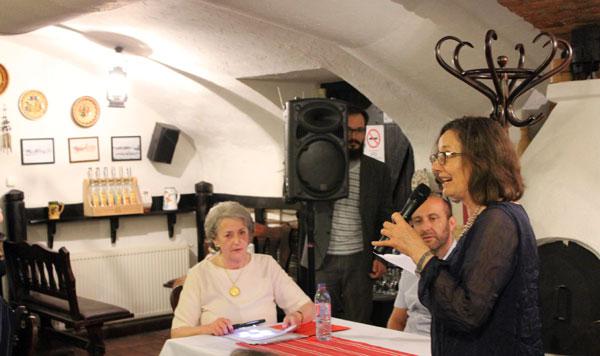
Brigitte Émile-Zola, introduced by Carolyn Snipes-Hoyt

Brigitte Émile-Zola reading Hungarian letters to her famous great-grandfather
The third and last day of the conference featured papers on naturalism or the Dreyfus Affair in Central Europe. We began with a session on various historical factors contributing to the birth and evolution of naturalism. For example, the name of Zola’s fictitious character “Nana” corresponds to the name “Nanna,” the heroine of the Ragionamenti (1534-1539) by Pietro Aretino, the first figure and emblematic writer of Western libertinage. Is this just a coincidental connection or is there a direct influence from this libertine tradition on Zolian naturalism? As for Mirbeau, he distanced himself from the Zolian naturalist model, after reading Dostoyevsky and submitting to the influence of the Russian author. Parallel to this session, another took place on naturalism and naturalist writers in Hungary. Beyond addressing the question of the specificity of Hungarian naturalism, this session enabled us to discover naturalist writers from this country, such as Sándor Bródy, Zsigmont Justh and Desző Szomory. After lunch our third Invited Guest, Miklós Konrád, made his presentation titled “L’affaire Dreyfus dans la presse juive hongroise.” Reverberations of the Affair appeared in the news weekly Egyenlőség, founded in 1892. Following the events of the Affair, the writers for this periodical began to question not only the accusations brought against Jews, but also the political situation in France, and along those lines, the role public opinion was playing in European societies. It goes without saying that Zola was identified by Hungarian Jews as exemplary, playing the role both of an intellectual in the debate and as defender of Truth and Justice.
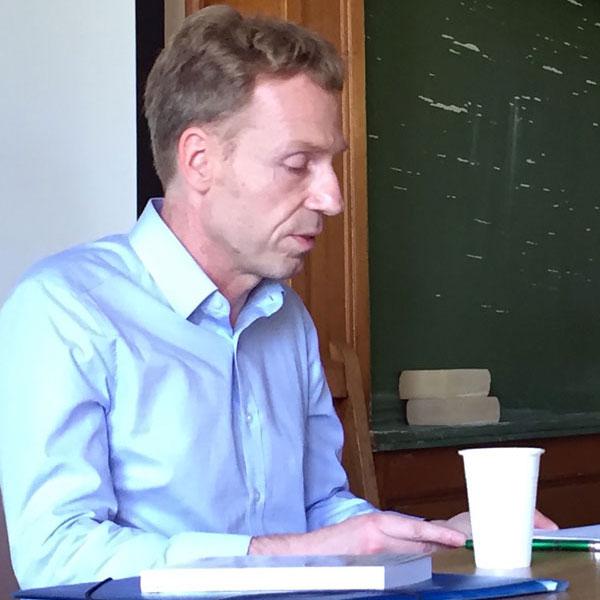
Miklós Konrád
The following session dealt with the reception and legacy of Zola and Mirbeau in various countries of Central Europe. At the same time, a session took place on Naturalism and Medical Discourse in Zola and Mirbeau. In a world where scientific progress was acquiring the importance it will be accorded in the 20th Century, it is not surprising that the two authors became interested in medical discourse and doctors, especially Mirbeau, who was the son of a physician. Zola too was fascinated with the figure of the doctor, as seen in a novel such as Le Docteur Pascal, which could legitimize his own novelistic undertaking and his naturalist vision.
To close the conference and return to the celebration of the centenary of Octave Mirbeau’s death, a special panel was devoted to the influence Zola had on his contemporary’s famous novel Le Journal d’une femme de chambre. We can say that this eighteenth AIZEN conference was of a high intellectual caliber, that it put forward an entire new generation of very promising young researchers, and it allowed us to discover unresearched aspects of Zola, Mirbeau and naturalism. After the closing remarks made by Anna Gural-Migdal during the AIZEN Wine Reception, the conference-goers could spend the evening sipping Hungarian wines on the terrace of the Hunguest Hotel Nagyerdő.
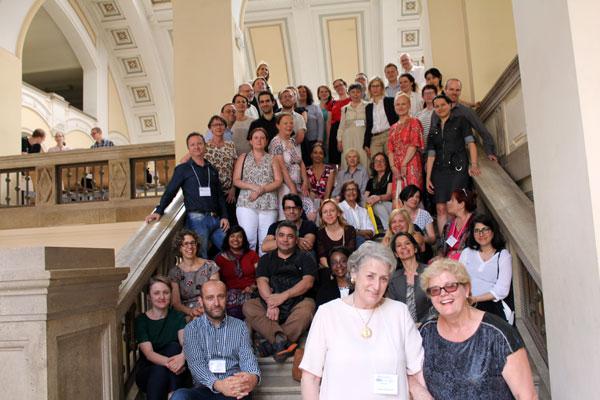
Conference family portrait
On Sunday, the weather was perfect for an excursion when participants discovered not only the beauty of the Hungarian countryside, but also got to know each other better in a relaxed and pleasant atmosphere. The day’s program began with a guided visit to Debrecen, with a population of approximately 207 000, the second largest city in Hungary. It is in the comitat of Hajdú-Bihar, 230 kilometers to the east of Budapest and 35 kilometers from the Romanian border. Since a large portion of the population of this city is Protestant, it is nicknamed “Calvinist Rome.” In 1849, during the Hungarian Revolution against Habsburg domination, Debrecen became the capital of Hungary for a short period of time. The revolutionary Lajos Kossuth, proclaimed the independence of Hungary in the great church of Debrecen Nagytemplom. We stood on Calvin Square and gazed up at the magnificence of this Church, the most characteristic building in the city. Constructed between 1805 and 1824 in a neo-classical style, it is the symbol of the Reformation in Hungary. We were able to admire the statue of Kossuth, the major figure of Magyar nationalism, who was elected Governor-President of Hungary. Then we walked around the Deri Museum, one of Hungary’s foremost establishments of its kind. In addition to exhibits of local cultural interest, it has become known for its collection of items brought together by Frigyes Déri, representing various aspects of universal human civilization. We noticed a group of four statues in the garden outside this museum, the work of Ferenc Medgyessy, awarded the Grand Prize at the 1937 Paris World Exposition.

The Great Reformed Church of Debrecen
We got back into the bus, and took note as we passed by, of the Csokonai Theatre, a unique building constructed in the romantic style; and we headed toward the major tourist attraction and holiday destination in the region: the Hortobágy Puszta. Hortobágy is Hungary’s largest national park, created in 1973, on a 52,000-acre property, and then progressively enlarged, now covering an area of 80,000 acres. Since 1979, the park is a UNESCO world biosphere and in 1999 became a World Heritage Site. This Hungarian steppe is known for typical fauna, such as grey Hungarian cattle, water buffalo, wild horses, Racka sheep, woolly pigs, and the great bustard. Upon our arrival at the park, we had the opportunity to observe the harmony achieved between man and horse, during the demonstration by the equerry (csikós) against the backdrop of the lovely Nine-Span-Bridge. We took note of the thatched-roofed barns of the Puszta, as well as of the typical clothing, daily objects and work of a shepherd. We watched the events of an Hungarian Folk Festival, with dancers and singers in traditional costumes on stage. As part of the visit, conference participants were treated to a 90-minute horse-drawn carriage ride. They enjoyed the adventure, while familiarizing themselves with the grandiose landscape of the puszta, its unique atmosphere and the livestock raised on immense open pastures. The visit ended with a walk-through of the stables. After this, we attended the Nadudvar pottery workshop run by master potter József K. Nagy. Conference participants who wanted to do so had a chance to ride a horse under the supervision of a csikós. We then enjoyed a delicious country lunch in the Hortobágy Inn. On the menu: Guinea fowl soup, a filled crêpe à la Hortobágy, Hungarian goulash, and apple strudel.
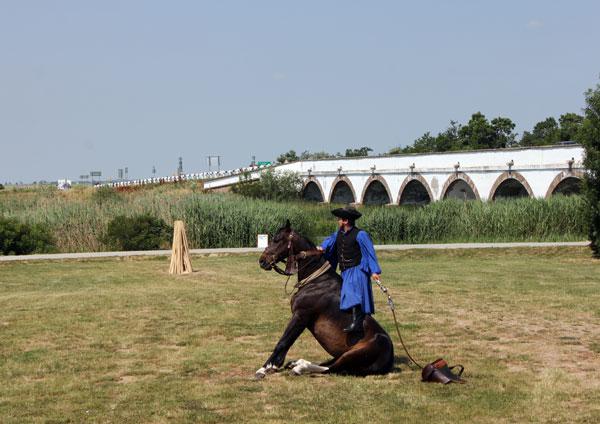
Csikós on the Puszta

Horse-drawn carriages
After this repast, our excursion continued in the direction of Eger, one of the oldest cities in Hungary, the seat for the district (jarás) of Eger and for the county (megye) of Heves. The city is situated in the north of the country, to the east of Mátra, the highest mountain range in Hungary. Its present population is 54 864. Eger is known as much for its vineyards and its red wine − “bull’s blood” (Egri bikavér) −, as for its unique architectural heritage: its minaret, a vestige of the Ottoman occupation; its medieval fortress; its basilica (the second largest in Hungary, after the one in Esztergom); and its numerous Barock buildings. We took a walking tour in Eger and immersed ourselves in the atmosphere, listening to street performers play Hungarian gypsy tunes. Dobó Square was vibrant on this summer evening, with children running about and playing in the water fountains. This square was reconstructed in 2014 and is referred to as the heart of Eger since, from this point, you can visit the city’s major monuments in a few minutes on foot. One statue in the square is dedicated to an important historical event of Eger: the commemoration of the castle’s heroic Captain Dobó. The Dobó statuary group was created by the famous sculptor Alajos Stróbl and inaugurated in 1907.
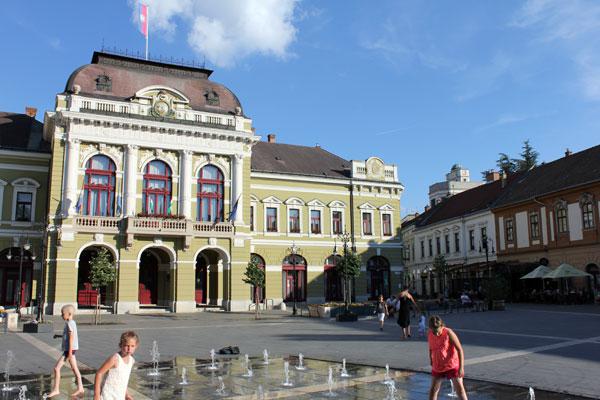
Dobó Square, Eger
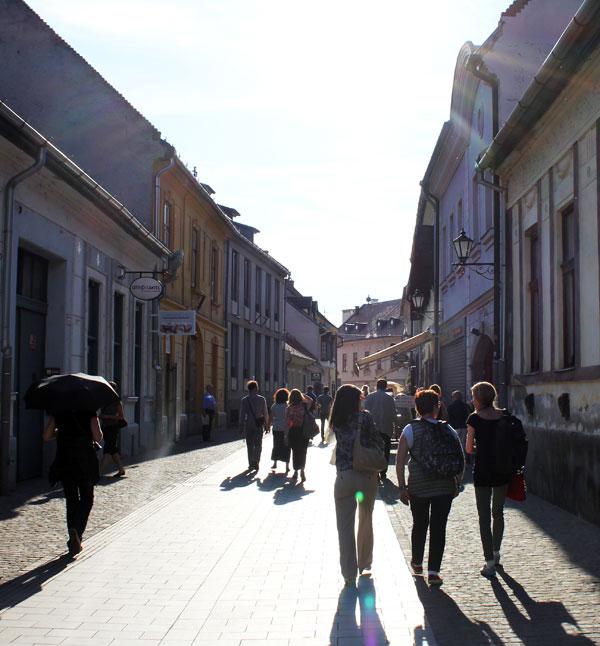
The streets of Eger
The guided walking tour was followed by a visit to Eger’s famous wine cellar system, more than 250 meters in length, and the national wine museum István Pince és Nemzeti Bormúzeum, with an entrance, curiously, through the Beatles Museum. After an introduction to the Hungarian wine collection exhibit, a wine-tasting and buffet of cold hors-d’œuvres (bacon, smoked ham, head cheese, sausage, smoked cheese, onions, peppers, tomatoes, cucumbers, etc.) was served to participants in the Cave in an atmosphere à la Harry Potter. It was also a very special day since we were celebrating Anna Gural-Migdal’s birthday. Carolyn Snipes-Hoyt and Marie-Sophie Armstrong made speeches in her honour, not only to offer her birthday wishes, but also to thank her on behalf of the participants for her tremendous work since the AIZEN/University of Debrecen Conference was her last one as organizer-in-chief. Big portions of a creamy cake were distributed and Anna Gural-Migdal received gifts from Justine Huet, Carolyn Snipes-Hoyt, Anna Keszeg, and Sándor Kálai. This was a memorable day, which will remain engraved on our memories and will bring to a brilliant end Anna’s mandate as President of the AIZEN.

The end of a memorable evening
NEWS ABOUT OUR MEMBERS
It is with deep sadness that the AIZEN announces the passing of Gabriella Tegyey, Director of the French Department at the University of Debrecen, one of the host departments of the International Conference on “Zola, Mirbeau and Naturalism.” As the Director of this department and a member of the Local Organizational Committee, Dr. Tegyey was supposed to open the symposium and honour us with her presence throughout the event, but was unable to do so because of her illness. We are deeply moved that, despite her suffering, Gabriella insisted on sending us the text of her communication. Her excellent paper was read by the President of the AIZEN, Anna Gural-Migdal, on Saturday, June 10, 2017, during the session on Naturalism and Naturalist Writers in Hungary. We dedicate this Bulletin to the memory of Gabriella and will publish her article posthumously in Vol. XXXI of Excavatio. Besides her work on Mirbeau, another of Gabriella Tegyey’s areas of expertise was literary relations between France and Hungary in the 19th and 20th centuries.

Gabriella Tegyey
Congratulations to Riikka Rossi, a docent from the University of Helsinki, who was recently appointed Maître de conférence at the University of Tampere in Finland. Dr. Rossi will begin her new position in 2019. Congratulations to the new Secretary of the AIZEN, Ana Oancea, who was appointed Assistant Professor at the University of Delaware. Hats off to Roderick Cooke, our Treasurer, who has been appointed Assistant Professor at Villanova University. Roderick and Ana will be active in their new positions in the Fall of 2018. These are three talented and prolific Zola specialists, who have contributed greatly to the AIZEN. Congratulations to Catherine Dousteyssier-Khoze, Deputy Head, School of Modern Languages and Cultures at Durham University, for her promotion to Professor.
We also congratulate Corinne Loreaux-Kubler, Marion Glaumaud-Carbonnier and Mihály Benda, for having successfully defended their doctoral theses. Corinne Loreaux-Kubler’s thesis, titled “La face cachée des Rougon-Macquart de Zola,” was defended under the direction of Alain Pagès at the Université Sorbonne Nouvelle – Paris 3, France. Marion Glaumaud-Carbonnier’s thesis, titled “Quereller l’azur. Lignes et figures du divorce dans le récit français (1870-1905),” also completed her thesis under the direction of Alain Pagès at the University Sorbonne Nouvelle – Paris 3, France. Mihály Benda defended his thesis, titled “L’écriture et la visualité dans le Voyage en Espagne et dans les critiques d’art de Théophile Gautier” (2017), under the direction of Éva Martonyi at the University Eötvös Loránd, in Hungary. Our best wishes to all three, for a productive and successful career.
Our members continue to be very active researchers and have published works of interest to scholars in the areas of Zola, naturalism, and 19th-century French Studies. Colette Becker and Pierre-Jean Dufief in collaboration with Jean-Sébastien Macke have produced a Dictionnaire des naturalismes (2 vols., Champion, 2017), which deals with naturalism’s influence and its struggles against deprecating views of its aesthetics, rehabilitating mainstream naturalists as well as lesser naturalists. This work gives an overview of naturalism’s influence all over the world, taking into account both the departures in far-flung outposts from the blueprint created by its leaders and what the different strains of naturalism have in common. A variety of approaches to naturalism are covered − its themes, forms of writing, social connections, publishing, and chronology. Colette Becker has also come out with Volume VII of the critical edition of La Fabrique des Rougon-Macquart (Champion, 2017), which includes Zola’s preparatory notes on Le Rêve and La Bête humaine, 16th and 17th novels in the series, which, through their stark differences, illustrate the extreme versatility of a writer bent on surprising and engaging his readers.
Éléonore Reverzy, together with Nicolas Bourguinat, has edited a volume titled Les Goncourt historiens (Presses Universitaires de Strasbourg, 2017), which not only touches on the Goncourts’ ideas of the feminine, the theatre, painting, objects, and methods of style, but also on the way history enters their novels, as a silent presence, on the horizon, through accounts of ancestry and stories about the background of the characters. In this way the novelists Goncourts’ 18th Century dialogues with the Goncourts themselves, known to be collectors and esthetes. Jean-Louis Cabanès has edited Volume XII of Edmond de Goncourt, Œuvres narratives complètes. Chérie. Roman testament et roman décadent (Classiques Garnier, 2018), a novel that disconcerted the public in 1884 when it appeared, seemingly a compilation of documents with a deliberate avoidance of plot, taking to the extreme the precepts of naturalism and inscribing itself in symbolist aesthetics. Cabanès’s edition includes a preface, an introduction, and several annexes.

Valerie Minogue, President of the Emile Zola Society, London since 2005, has translated Zola’s novel La Faute de l’abbé Mouret into English, with the title The Sin of Abbé Mouret (Oxford University Press, Oxford World Classics, 2017). She has rendered the lyricism and extravagant beauty of the descriptions into impeccable English and provided a wide-ranging introduction to this novel and useful explanatory and historical notes.
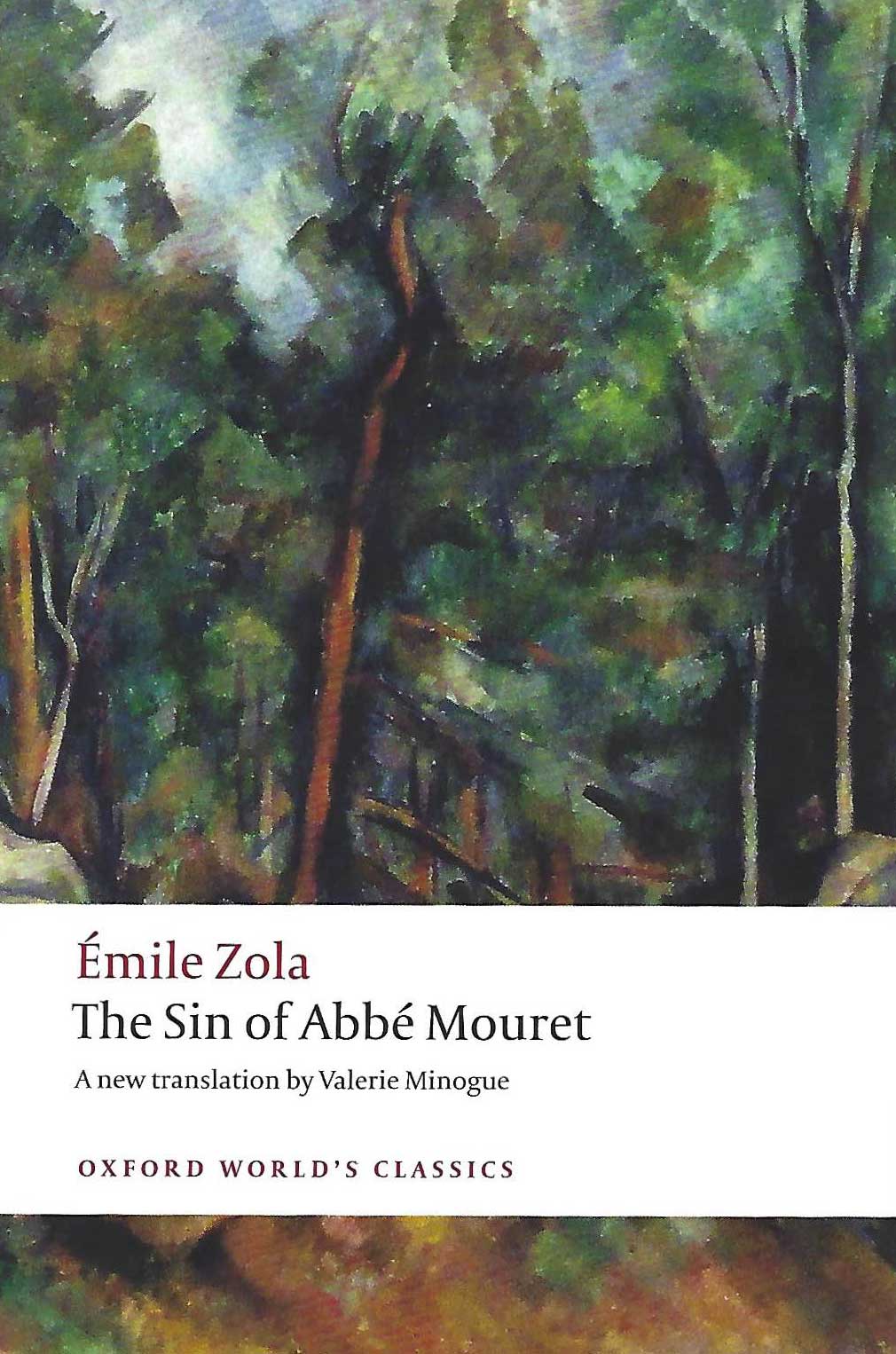
Marjorie Rousseau-Minier is the author of Des filles sans joie. Le roman de la prostituée dans la seconde moitié du XIXe siècle (Droz, 2018), dealing with the rise of the prostitute as heroine in fiction, in French, Spanish, and Russian works. This comparative study considers medical, moral and social discourses of the period and points to the “fille” as a figure of lack and dispossession, from the masculine perspective, revealing contemporary concerns and anxieties.

Céline Grenaud-Tostain and Olivier Lumbroso have edited a volume of essays, “Naturalisme – Vous avez dit naturalismes?” Héritages, mutations et postérités d’un mouvement littéraire (Presses Sorbonne nouvelle, 2016), in which the question of stereotypical views of naturalism is addressed and reconsidered, in light of the variations of naturalism that developed in France, in Europe, and abroad, including very recent manifestations. Reciprocal perspectives are brought to bear on these multiple heritages, with the suggestion that a broader vision is needed and a new approach termed “naturalist humanities.” Carine Goutaland has authored a book titled De régal en dégoûts. Le naturalisme à table (Classiques Garnier, 2017), in which the naturalist novelist is seen as an “eater,” obsessed with devouring reality. This work questions the ambiguities of the novelistic “meal,” the principal site of the materialist project and actual field of literary experimentation.
Anna Kaczmarek-Wiśniewska has authored a book titled La vie quotidienne à Paris suivant les chroniques d’Émile Zola: un regard oblique (Uniwersytet Opolski, 2017), dealing with Zola’s views as expressed in his journalistic writings on various aspects of contemporary Paris, all coloured by his discontent with the situation in the Second Empire. The ten essays in this volume cover the following five general areas: the city as both a topographic and a symbolic space; the education offered by different institutions for boys and girls; the dysfunctionalities present in both the lower and upper classes; entertainment and leisure; and death in the City of Light.
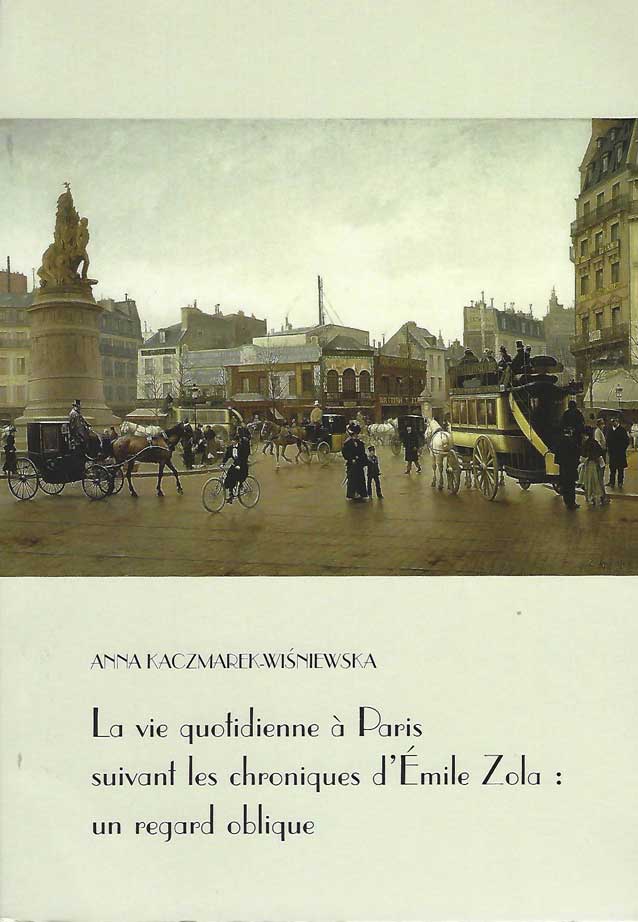
Michael Rosenfeld has brought out an important new edition of Confessions d’un homosexuel à Émile Zola (Nouvelles éditions Place, 2017), based on a series of letters, first written to Zola by a young Italian aristocrat in 1889. Zola evidently passed them on to Dr. Georges Saint-Paul, who published them as a story, “Roman d’un inverti,” part of a work titled Tares et poisons. Perversion et perversité sexuelles (1896), which was re-edited in 1910, with reference to more letters from the young aristocrat. Rosenfeld’s edition re-produces the hand-written letters in their entirety for the first time and comments on the original omissions. The work features a preface by publisher Cyril Zola-Place, the great-great-great grandson of Zola, an avant-propos by Alain Pagès, and an annexe by Clive Thompson, dealing with Dr. Saint-Paul.
Soundouss El Kettani and Geneviève De Viveiros have published a volume of eight essays on Zola’s correspondence, with the title “Au courant de la plume,” Zola et l’épistolaire (Presses universitaires du Québec, 2018). The volume, with a Preface by Dorothy Speirs, explores letter-writing as a genre, which Zola engaged in during his entire life, as a tool for literary combat, for personal reasons and for mustering the naturalist troops. It includes essays by members and friends of the AIZEN, such as Alain Pagès, Jeremy Worth, Jean-Sébastien Macke, Sébastien Roldan, and by the editors of the volume.

Catherine Dousteyssier-Khoze has authored a monograph titled Claude Chabrol’s Aesthetics of Opacity (Edinburgh University Press, 2018), about the famous French filmmaker’s unique approach to his art. While Chabrol’s works are usually characterized as psychological thrillers or melodrama set in the bourgeois confines of the French province, Dousteyssier-Khoze argues that an aesthetics of opacity dominates within the apparent clarity and “comfort” of the generic frame and that the filmmaker intermingles various levels, such as the actual and the virtual, in his films, in a subversion of reality itself.
Many other volumes will appear shortly: first of all, Lire Zola au XXIe siècle, Actes du Colloque de Cerisy-la-Salle, under the direction of Aurélie Barjonet and Jean-Sébastien Macke (Classiques Garnier, 2018); then, Mélanges offerts à Alain Pagès, edited by Olivier Lumbroso, Jean-Sébastien Macke and Jean-Michel Pottier, which will appear with the Presses de la Sorbonne Nouvelle (2019); and finally, Émile Zola et Octave Mirbeau: Regards croisés, edited by Anna Gural-Migdal and Sándor Kálai (Classiques Garnier, 2019).
As for our most recent issue of Excavatio, we are pleased to announce that Vol. XXX (2018), titled “Émile Zola, Octave Mirbeau and Naturalism,” is now posted and available to read on-line. With an introduction by Anna Gural-Migdal, this volume features a total of 12 articles, among them a presentation of the Dictionnaire des naturalismes, by its editors, Colette Becker and Pierre-Jean Dufief, studies dealing with Zola and/or Mirbeau, and a special section devoted to the influence and reception of Zola in Brazil. You can access our journal on line at the following link: http://aizen.Zolanaturalismassoc.org/excavatio/index.html. As Editor-in-Chief of the review, Anna Gural-Migdal would first like to thank Sándor Kálai, since many of the articles in Vol. XXX of Excavatio are recast versions of papers presented at the International AIZEN/University of Debrecen Conference. Thank you also to all members of the Excavatio team, made up of Associate Editors Marie-Sophie Armstrong and Carolyn Snipes-Hoyt, Editorial Assistant Lisa Ng, and Philip Hoyt, who posts our journal on-line.
EXCAVATIO
International Review for Multidisciplinary Approaches and Comparative Studies Related to Émile Zola and Naturalism Around the World
Editor: Anna Gural-Migdal
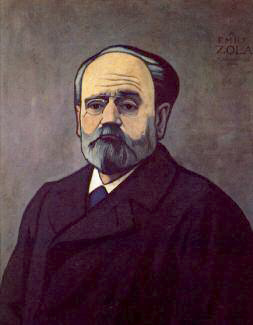
Émile Zola by Félix Vallotton (1902)
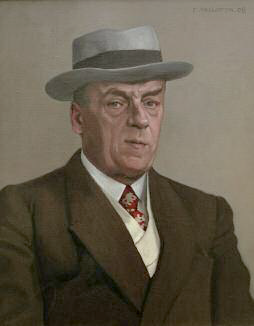
Octave Mirbeau by Félix Vallotton (1908)
VOL. XXX, 2018
ÉMILE ZOLA, OCTAVE MIRBEAU AND NATURALISM
We would like to encourage all AIZEN members to ask their librarians to order a complete collection of the first 23 volumes of Excavatio, which appeared in print only. To order this collection, just go the internet site AIZEN/Excavatio, at the following addresses:
In Canada: http://aizen.Zolanaturalismassoc.org/excavatio/order-canada.html
In the USA: http://aizen.Zolanaturalismassoc.org/excavatio/order-us.html
International: http://aizen.Zolanaturalismassoc.org/excavatio/order-intl.html
Since the new AIZEN team would like to put its own stamp on our Association and interest other researchers in becoming members, we encourage you to go to our Facebook page and “like” us! If you are not already a member of the AIZEN, become one or renew your membership, which is required for submitting articles for consideration by Excavatio.
We need your financial support to produce the on-line publication of Excavatio, and to plan the forthcoming conference and the festivities for the 30th anniversary of the AIZEN, which our new President Juliana Starr will be organizing in the USA, since that is where the AIZEN was founded. Before passing the torch to the new editors, for the next AIZEN Bulletin, Anna Gural-Migdal and Carolyn Snipes-Hoyt would like to thank the impressive number of prestigious scholars and talented young researchers who have contributed to making the AIZEN what it has become today, and to ensure the promotion of Zolian and naturalist studies all over the world.Anna Gural-Migdal and Carolyn Snipes-Hoyt, July 2018